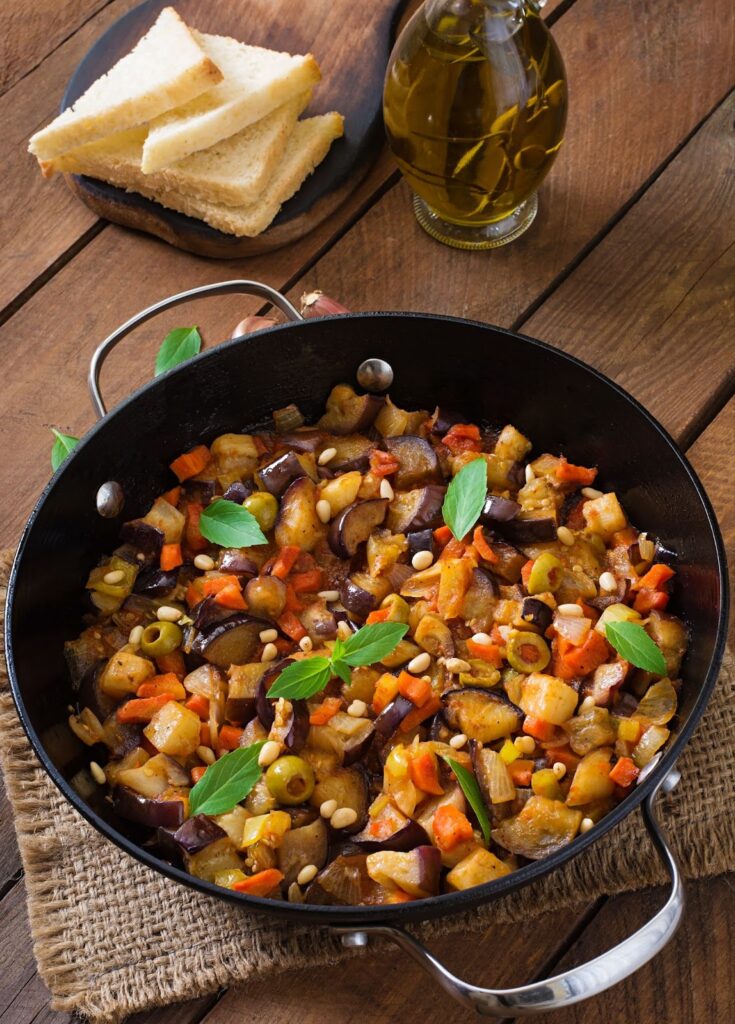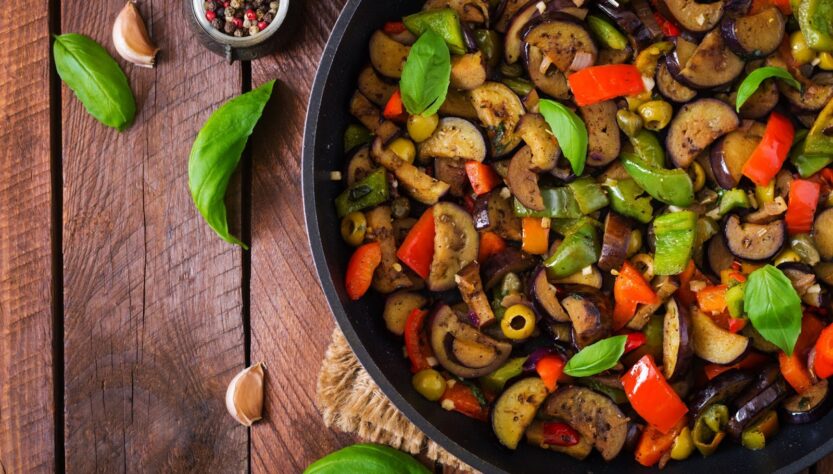Delve into the exquisite realms of culinary delight with this splendid recipe for Eggplant Caponata. A manifestation of authentic Italian gastronomy, this condiment boasts the ability to elevate bruschetta to celestial heights, entwine gracefully with pasta strands, or crown grilled meats with its delectable essence. Behold the embodiment of tradition, as caponata takes center stage in its time-honored glory, effortlessly assembled and primed for all occasions.
A cornucopia of caponata iterations unfurls before the epicurean explorer. Among them, a panoply of options, some bedecked with raisins, others adorned with the regal presence of hard-boiled eggs, or the subtle crunch of pine nuts. In the spotlight, I present my cherished caponata rendition, where kalamata olives bestow their rich character, jarred roasted red bell peppers infuse their smoky allure, and capers provide the final flourish of complexity. Allow me to unveil a symphony of taste that encapsulates the spirit of tradition while embracing the nuances of culinary creativity.
Exploring the Delectable World of Eggplant Caponata
Imagine a plate of culinary artistry that bursts with colors, flavors, and a rich history. Eggplant Caponata, a gem hailing from the sun-soaked island of Sicily, is a masterpiece that tantalizes taste buds and tells tales of tradition. It’s a symphony of diced, succulent eggplant, onions, celery, tomatoes, and a medley of vegetables harmoniously cooked to perfection. But that’s just the beginning of this culinary journey.
A Symphony of Ingredients and Variations
At the heart of Eggplant Caponata are the carefully selected ingredients that come together to create a dance of flavors on your palate. Imagine the earthy aroma of sautéed eggplant, the gentle sweetness of caramelized onions, and the refreshing crunch of celery. These core ingredients paint a vivid canvas, but the orchestra doesn’t stop there.
Elevating the dish to an even more enchanting level are olives, capers, and the elixir of Mediterranean cuisine – olive oil. These ingredients infuse depth and complexity into the caponata, transforming it into a culinary composition that balances tanginess, saltiness, and richness.
But the variations are as diverse as the stories of Sicily itself. Some renditions invite the subtle nuttiness of pine nuts, the occasional surprise of plump raisins, and the vibrant charm of carrots. Each variant adds its own chapter to the tale, revealing how a single dish can adapt and evolve across generations and regions.
Delectable Eggplant Caponata: A Savory Symphony of Flavors
Dive into the rich tapestry of tradition and innovation with our remarkable Eggplant Caponata recipe. This symphony of flavors melds together quintessential ingredients like luscious eggplants, vibrant tomatoes, aromatic onions, crunchy celery, and zesty capers. While the classics form the heart of this dish, we’re taking a delightful detour by introducing kalamata olives, foregoing the standard green variety. Additionally, we’re bypassing the raisins and pine nuts, giving you the creative freedom to tailor this culinary masterpiece according to your palate’s desires.
But before you embark on this culinary journey, ensure your kitchen is equipped with the ideal vessel. Enter the Le Creuset Braiser, a versatile companion for everyday cooking, adept at crafting succulent sauces or conjuring up delectable meatballs.
Setting the Stage: Preparing the Eggplant
The star of our show, the eggplant, takes center stage after a transformative preparation. Begin by dicing the eggplant into bite-sized wonders, around ½ to 1 inch cubes. To tease out its flavors and eliminate excess moisture, a ritualistic salting and draining is in order. Gently sprinkle the diced eggplant with the charm of kosher salt, ushering it into a colander for a moisture-defying session. Alternatively, tenderly lay these cubes upon sheets of paper towels, a canvas for their imminent metamorphosis.
Give the eggplant a stage to unveil its secrets for at least thirty minutes. Then, baptize it under the cool cascade of water to cast away the salt’s embrace. A paper towel’s gentle touch shall pat it dry, revealing a transformed canvas, ready to absorb and infuse the forthcoming symphony of flavors.
Harmonious Choreography: Pan-Frying the Ensemble
While the eggplant communes with salt, let us choreograph the movements of the supporting ensemble. A melodious dance begins with finely diced onions and celery. In the spacious embrace of a skillet or dutch oven, heat the olive oil to an inviting warmth over medium heat. Introduce the diced duo of onion and celery, allowing them to perform a tender ballet for approximately 7 minutes, until their grace softens them. A crescendo of aromas follows as garlic joins the ballet, pirouetting for another minute. Exit stage left as the vegetables are tenderly removed and set aside, awaiting their triumphant return.

A change of scene, a sizzling encore: Heat another portion of olive oil in the same pan, now at medium-high heat. In steps the eggplant, reimagined and rejuvenated after its transformative soak. Witness its metamorphosis into golden-brown perfection, a process that takes around 10 minutes. A symphony of flavors and textures evolves as this eggplant rejoins the dance.
The Grand Finale: A Culinary Crescendo
As the eggplant unfurls its finale, embrace its transformation with open arms. Reunite the once-separated ensemble as the onion mixture rejoins the spotlight. Commence the flavorful sonata by adding diced plum tomatoes, fire-roasted red bell peppers, the allure of kalamata olives, the zest of capers, and a medley of seasonings. With a gentle orchestration, summon the simmering of flavors to a gentle crescendo.
With anticipation hanging in the air, reduce the heat to let the caponata simmer and evolve. Watch as the liquid weaves its magic, evaporating into whispers of flavor, softening the textures and intensifying the symphony. Allow the ensemble to cool, a bow of respect to the culinary performance that’s been staged.
For those who dare to extend the suspense, a waiting period within the refrigerator for a day or two is highly recommended. This interlude only serves to deepen the flavors, bringing about a heightened appreciation for this caponata symphony. An exercise in patience, this step is a testament to the rewards that come to those who savor the anticipation.
Conclusion
In conclusion, eggplant caponata stands as a shining example of the harmonious marriage between culinary artistry and cultural heritage. This Sicilian delicacy, with its rich history and diverse flavors, exemplifies the power of food to transcend borders and evoke a sense of shared human experience. Through its medley of eggplant, tomatoes, olives, and capers, caponata paints a vivid portrait of Sicily’s vibrant agricultural landscape and centuries-old gastronomic traditions.
